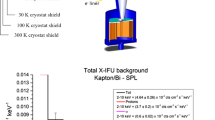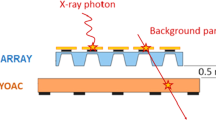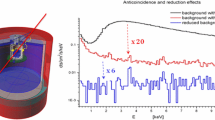Abstract
ATHENA is a large X-ray observatory, planned to be launched by ESA in 2028 towards an L2 orbit. One of the two instruments of the payload is the X-IFU: a cryogenic spectrometer based on a large array of TES microcalorimeters, able to perform integral field spectrography in the 0.2–12 keV band (2.5 eV FWHM at 6 keV). The X-IFU sensitivity is highly degraded by the particle background expected in the L2 orbit, which is induced by primary protons of both galactic and solar origin, and mostly by secondary electrons. To reduce the particle background level and enable the mission science goals, the instrument incorporates a Cryogenic AntiCoincidence detector (CryoAC). It is a 4 pixel TES based detector, placed < 1 mm below the main array. In this paper we report a scientific assessment of the CryoAC observational capabilities in the hard X-ray band (E > 10 keV). The aim of the study has been to understand if the present detector design can be improved in order to enlarge the X-IFU scientific capability on an energy band wider than the TES array. This is beyond the CryoAC baseline, being this instrument aimed to operate as anticoincidence particle detector and not conceived to perform X-ray observations.








Similar content being viewed by others
References
Nandra, K., Barcons, X., Barret, D., Fabian, A., den Herder, J.-W., Piro, L., Watson, M., et al.: ATHENA mission proposal http://www.the-athena-x-ray-observatory.eu/images/AthenaPapers/The_Athena_Mission_Proposal.pdf (2013). Accessed 09 Jan 2017
Nandra, K., Barcons, X., Barret, D., Fabian, A., den Herder, J.-W., Piro, L., Watson, M., et al.: ATHENA white paper http://www.the-athena-x-ray-observatory.eu/images/AthenaPapers/The_Hot_and_Energetic_Universe.pdf (2013). Accessed 09 Jan 2017
Barret, D., Lam Trong, T., den Herder, J.W., Piro, L., Barcons, X., et al.: The Athena X-ray integral field unit (x-IFU). In: Proc. SPIE 9905 Space Telescopes and Instrumentation 2016: Ultraviolet to Gamma Ray, 99052F (2016). doi:10.1117/12.2232432
Macculi, C., Argan, A., D’Andrea, M., Lotti, S., Laurenza, M., et al.: The cryogenic anticoincidence detector for ATHENA x-IFU: a program overview. In: Proc. SPIE 9905 Space Telescopes and Instrumentation 2016: Ultraviolet to Gamma Ray, 99052K (2016). doi:10.1117/12.2231298
Fraser, G.W.: X-ray Detectors in Astronomy. Cambridge Astrophysics Series (1989)
Bavdaz, M., Wille, E., Shortt, B., Fransen, S., Collon, M., et al.: The ATHENA optics development. In: Proc. SPIE 9905 Space Telescopes and Instrumentation 2016: Ultraviolet to Gamma Ray, 990527 (2016). doi:10.1117/12.2233037
Allison, J., et al.: Recent developments in Geant4. nuclear instruments and methods in physics research section a: accelerators, spectrometers, detectors and associated equipment, vol. 835, pp. 186–225 (2016). doi:10.1016/j.nima.2016.06.125
Chantler, C.T., Olsen, K., Dragoset, R.A., Chang, J., Kishore, A.R., Kotochigova, S.A., Zucker, D.S.: X-ray form factor, attenuation and scattering tables (version 2.1) http://physics.nist.gov/ffast (2005). Accessed 09 Jan 2017
Turler, M., Chernyakova, M., Courvoisier, T.J.L., et al.: INTEGRAL hard X-ray spectra of the cosmic X-ray background and galactic ridge emission. A &A 512, A49 (2010)
Lotti, S., Mineo, T., Jacquey, C., Molendi, S., D’Andrea, M., Macculi, C., Piro, L.: The particle background of the X-IFU instrument. In this issue (2017)
Harrison, F.A., et al.: The Nuclear spectroscopic telescope array (NuSTAR) high-energy X-ray mission. ApJ 770, 103 (2013). doi:10.1088/0004-637X/770/2/103
Lotti, S., Cea, D., Macculi, C., Mineo, T., Natalucci, L., Perinati, E., Piro, L., Federici, M., Martino, B.: In-orbit background of X-ray microcalorimeters and its effects on observations. A &A 569, A54 (2014). doi:10.1051/0004-6361/201323307
D’Andrea, M., Argan, A., Lotti, S., Macculi, C., Piro, L., Biasotti, M., Corsini, D., Gatti, F., Torrioli, G.: The Cryogenic Anti-Coincidence detector for ATHENA x-IFU: Pulse analysis of the AC-s7 single pixel prototype. In: Proc. SPIE 9905 Space Telescopes and Instrumentation 2016: Ultraviolet to Gamma Ray, 99055X (2016). doi:10.1117/12.2231412
Jourdain, E., Roques, J.P.: 5 years of survey on the Crab Nebula with SPI/ INTEGRAL. In: Proceeding of The 7th INTEGRAL Workshop in Copenhagen, Denmark (2008)
Arnaud, K.A.: XSPEC: The first ten years. In: Jacoby, G. and Barnes, J. (eds.) Astronomical Data Analysis Software and Systems, vol. p17. ASP Conf Series volume 101 (1996)
Lazanua, I., Lazanub, S.: Contribution of the electron-phonon interaction to Lindhard energy partition at low energy in Ge and Si detectors for astoparticle physics applications. Astropart. Phys. 75, 44–54 (2016). doi:10.1016/j.astropartphys.2015.09.007
Acknowledgements
The research leading to these results has received funding from the European Union’s Horizon 2020 Programme under the AHEAD project (grant agreement n. 654215).
Author information
Authors and Affiliations
Corresponding author
Rights and permissions
About this article
Cite this article
D’Andrea, M., Lotti, S., Macculi, C. et al. The Cryogenic AntiCoincidence detector for ATHENA X-IFU: a scientific assessment of the observational capabilities in the hard X-ray band. Exp Astron 44, 359–370 (2017). https://doi.org/10.1007/s10686-017-9543-4
Received:
Accepted:
Published:
Issue Date:
DOI: https://doi.org/10.1007/s10686-017-9543-4




